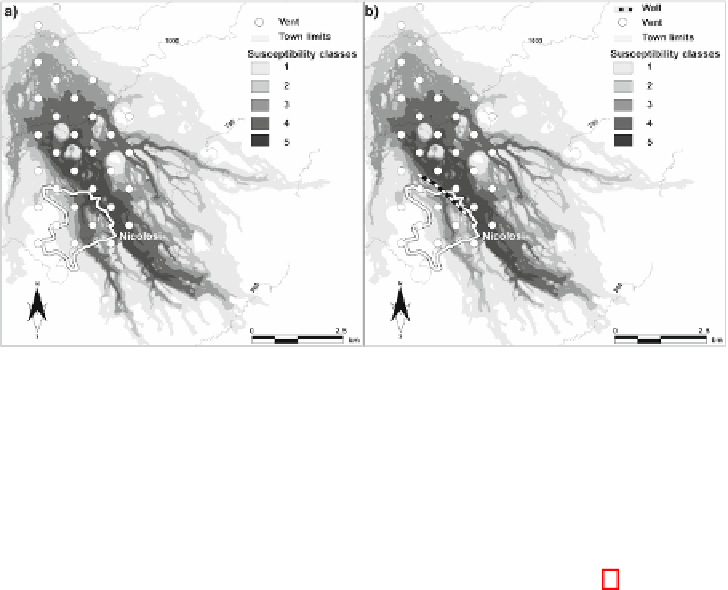Information Technology Reference
In-Depth Information
Fig. 7.
(a) Map showing the location of a set of vents (white dots) which originate lava flows
intersecting a hypothetical 2 km long and 20 m tall earth barrier (see b - right) to protect the centre
of Nicolosi (white line); (b) The same area considered in (a), together with the scenario resulting
from lava flows intersecting the barrier, which are re-simulated on a modified topography that
embeds the presence of the barrier. As shown, the hazard decreases by two classes within the
town limits (white line).
Results show that the barrier would indeed be necessary to effectively protect the
town centre. The susceptibility here decreases by two classes (Figure 7b) and, at the
same time, the areas invaded by diverted flows prove characterised by only a slightly
higher susceptibility degree. In this specific case, the protective measure has a sub-
stantially positive effect. If this was not the case, further experiments with barriers of
different positions and dimensions will reveal to what degree damage from lava flow
invasion can be minimized, or whether it would be preferable to abandon any prospects
of this kind of protective measure.
5
Conclusive Remarks
The fundamental problem of assessing the impact of future eruptions in a volcanic re-
gion lies mostly in the uncertainty concerning their duration, effusion rate, and location.
A valid assessment tool relies on the adoption of volcanic hazard maps which, however,
are usually based on the sole analysis of past events. Conversely, maps should repre-
sent the full range of probable hazards that can be expected to an agreed probability,
considering thus all potential future scenarios. As a consequence, probabilistic hazard
maps can provide a better base for planning mitigation strategies. We tackled this issue
by an elaborate approach in the numerical simulation of a wide variety of lava flows,
which are typical of Etna for duration and effusion rate, on a dense grid of vents, by
attributing them a statistical likelihood. The methodology here presented deeply re-
lies con the application of the latest SCIARA CA model release, which re-introduces
a square tessellation of the cellular space instead of the previously adopted hexagonal
one, solves the anisotropic flow direction problem. This result is particularly significant,

Search WWH ::

Custom Search